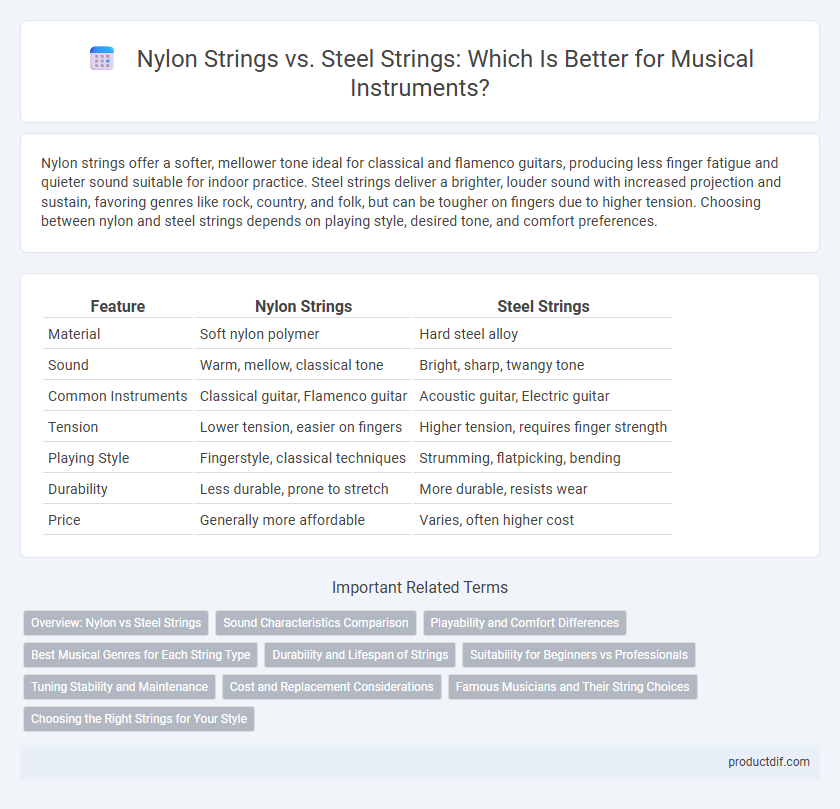Nylon strings offer a softer, mellower tone ideal for classical and flamenco guitars, producing less finger fatigue and quieter sound suitable for indoor practice. Steel strings deliver a brighter, louder sound with increased projection and sustain, favoring genres like rock, country, and folk, but can be tougher on fingers due to higher tension. Choosing between nylon and steel strings depends on playing style, desired tone, and comfort preferences.
Table of Comparison
| Feature | Nylon Strings | Steel Strings |
|---|---|---|
| Material | Soft nylon polymer | Hard steel alloy |
| Sound | Warm, mellow, classical tone | Bright, sharp, twangy tone |
| Common Instruments | Classical guitar, Flamenco guitar | Acoustic guitar, Electric guitar |
| Tension | Lower tension, easier on fingers | Higher tension, requires finger strength |
| Playing Style | Fingerstyle, classical techniques | Strumming, flatpicking, bending |
| Durability | Less durable, prone to stretch | More durable, resists wear |
| Price | Generally more affordable | Varies, often higher cost |
Overview: Nylon vs Steel Strings
Nylon strings produce a warm, mellow tone ideal for classical and flamenco guitars, offering softer tension that is easier on the fingers and enhances playability. Steel strings deliver a bright, crisp sound suited for acoustic, folk, and country styles, with higher tension providing increased volume and sustain. Choosing between nylon and steel strings depends on the desired sound profile and playing style, as each material significantly influences the guitar's tonal characteristics and performance.
Sound Characteristics Comparison
Nylon strings produce a warm, mellow tone with softer attack, ideal for classical and flamenco guitars, while steel strings deliver a brighter, louder, and more projecting sound suited for folk, rock, and country music. The flexibility of nylon results in a smoother, less metallic timbre, whereas steel strings offer enhanced sustain and sharper tonal clarity. Differences in material density and tension directly influence the resonance and dynamic range of the instrument.
Playability and Comfort Differences
Nylon strings offer softer tension and smoother texture, making them easier on the fingers and ideal for beginners or extended playing sessions. Steel strings provide higher tension and a brighter tone but can cause more finger fatigue and discomfort, especially without calluses. This contrast in playability and comfort significantly influences the choice between classical guitars with nylon strings and acoustic guitars with steel strings.
Best Musical Genres for Each String Type
Nylon strings are best suited for classical, flamenco, and folk music due to their warm, mellow tone and softer tension, which enhances fingerstyle playing and intricate melodies. Steel strings excel in genres like rock, country, and bluegrass, providing bright, crisp sound and greater projection for strumming and aggressive playing styles. Choosing between nylon and steel strings depends on the desired tonal qualities and playing techniques characteristic of each musical genre.
Durability and Lifespan of Strings
Nylon guitar strings generally offer a shorter lifespan compared to steel strings due to their susceptibility to stretching and wear from humidity and frequent playing. Steel strings exhibit superior durability, maintaining tension and tonal quality for a longer period under similar playing conditions. Musicians seeking longevity often prefer steel strings for genres requiring frequent string changes and robust performance.
Suitability for Beginners vs Professionals
Nylon strings offer a softer feel and lower tension, making them ideal for beginners developing finger strength and calluses. Steel strings provide brighter tone and greater volume, preferred by professionals seeking dynamic range and projection in genres like rock and blues. Choice depends on playing style and skill level, with nylon favoring classical and fingerstyle techniques while steel suits strumming and aggressive picking.
Tuning Stability and Maintenance
Nylon strings offer superior tuning stability due to their lower tension and elasticity, making them less prone to stretching and detuning over time compared to steel strings. Steel strings require more frequent tuning adjustments and maintenance, as they are more susceptible to environmental changes like humidity and temperature. Regular cleaning and proper string replacement are essential for steel strings to maintain optimal sound quality and tuning stability.
Cost and Replacement Considerations
Nylon strings typically cost less than steel strings, making them a budget-friendly option for guitarists. Replacement frequency varies since nylon strings are more prone to stretching and wear, often requiring more frequent changes compared to the durable steel strings. Cost efficiency should consider both the initial price and the lifespan of the strings based on playing style and instrument type.
Famous Musicians and Their String Choices
Famous musicians like Andres Segovia favored nylon strings for their warm, mellow tone, essential in classical guitar performances, while rock legends such as Jimi Hendrix preferred steel strings for their bright, sharp sound and increased durability. Nylon strings cater to fingerstyle players due to their softer touch and lower tension, contrasting with steel strings favored by electric guitarists seeking higher volume and sustain. The choice of strings significantly influences a musician's signature sound, with iconic artists shaping public perception of string suitability for various music genres.
Choosing the Right Strings for Your Style
Nylon strings offer a softer, mellower tone ideal for classical, flamenco, and fingerstyle guitarists seeking warmth and smooth playability. Steel strings produce a brighter, louder sound preferred by folk, rock, and country musicians who require durability and dynamic range. Selecting between nylon and steel strings depends on your musical genre, playing technique, and desired tonal character to enhance performance and comfort.
Nylon strings vs Steel strings Infographic

 productdif.com
productdif.com